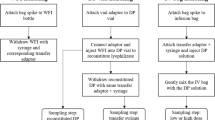Abstract
Formulation development of KO-947-K mesylate injectable drug products was described. Solution formulations were initially attempted, and key parameters such as drug concentration, buffer, pH, complexing agent, and tonicity modifying agent were carefully evaluated in the lab setting, mainly focusing on solubility and chemical stability. A lead solution formulation was advanced to a scaleup campaign. An unexpected stability issue was encountered, and the root cause was attributed to the heterogeneous liquid freezing process of the formulated solution at −20°C, which had not been captured in the lab setting. A lyophilized product was then designed to overcome the issue and supplied to the phase I clinical trial.
Graphical abstract





Similar content being viewed by others
References
Chin HM, Lai DK, Falchook GS. Extracellular signal-regulated kinase (ERK) inhibitors in oncology Clinical trials. J Immunother Precis Oncol. 2019;2(1):10–6.
Sullivan RJ, Infante JR, Janku F, Wong DJL, Sosman JA, Keedy V, et al. First-in-class ERK1/2 inhibitor ulixertinib (BVD-523) in patients with MAPK mutant advanced solid tumors: results of a Phase I dose-escalation and expansion study. Cancer Discov. 2018;8(2):185–95.
Buchbinder EI, Cohen JV, Haq R, Hodi FS, Lawrence DP, Giobbie-Hurder A, et al. A phase II study of ERK inhibition by ulixertinib (BVD-523) in metastatic uveal melanoma. J Clin Oncol. 2020;38(15):10036.
Pant S, Bendell JC, Sullivan RJ, Shapiro G, Millward M, Mi G, et al. A phase I dose escalation (DE) study of ERK inhibitor, LY3214996, in advanced (adv) cancer (CA) patients (pts). J Clin Oncol. 2019;37(15_suppl):3001.
Li L, Wu T, Feng J, Ren P, Liu Y. Inhibitors of ERK and methods of use. US Patent No. US-9624228-B2. Available from: https://pubchem.ncbi.nlm.nih.gov/patent/US-9624228-B2.
Mei B, Zhu L, Guo Y. Wu T, Ren P, Deng X. Solid form selection and process development of KO-947 drug substance. Org. Process Res. Dev. 2021; In revision.
Akers MJ. Sterile drug products formulation, packaging, manufacturing, and quality. 1st ed. Essex: Informa Healthcare; 2010.
Braga SS. Cyclodextrins: Emerging medicines of the new millennium biomolecules. 2019;9(12):801–19.
Loftsson T, Jarho P, Masson M, Jarvinen T. Cyclodextrins in drug delivery. Expert Opin Drug Deliv. 2005;2(2):335–51.
Scavone C, Bonagura AC, Fiorentino S, Cimmaruta D, Cenami R, Torella M, et al. Efficacy and safety profile of diclofenac/cyclodextrin and progesterone/cyclodextrin formulations: A review of the literature data. Drugs R D. 2016;16(2):129–40.
Akers MJ. Formulation and stability of solutions. Int J Pharm Compd. 2016;20(2):137–41.
Lam P, Morre J. Freezing, biopharmaceutical products. In: Flickinger MC, editor. Encyclopedia of industrial biotechnology. New York: John Wiley & Sons; 2010. p. 2567–81.
Butreddy A, Dudhipala N, Janga KY, Gaddam RP. Lyophilization of small-molecule injectables: an industry perspective on formulation development, process optimization, scale-up challenges, and drug product quality attributes. AAPS PharmSciTech. 2020;21(7):252.
Puri M, Morar-Mitrica S, Crotts G, Nesta D. Evaluating freeze–thaw processes in biopharmaceutical development – small-scale study designs. BioProcess International. 2015. https://bioprocessintl.com/manufacturing/fill-finish/evaluating-freeze-thaw-processes-biopharmaceuticaldevelopment-small-scale-study-designs/.
Debenedetti PG, Stillinger FH. Supercooled liquids and the glass transition. Nature. 2001;401(6825):259–67.
Altieri A. Jamming and glass transitions in mean-field theories and beyond. New York: Springer; 2019. p. 9–43.
Ediger MD, Harrowell P. Perspective: supercooled liquids and glasses. J Chem Phys. 2012;137(8):080901–1100.
Zanotto ED, Cassar DR. The race within supercooled liquids—Relaxation versus crystallization. J Chem Phys. 2018;149(2):024503–700.
Acknowledgements
We wish to thank Mrs. Caryn Peterson and Mr. Dennis Hester for useful discussions, Dr. Antonio Gualberto and Dr. Catherine Scholz for clinical inputs, and Dr. Tiffany Montellano and Dr. Blake Tomkinson for reviewing the manuscript.
Author information
Authors and Affiliations
Corresponding author
Additional information
Publisher’s Note
Springer Nature remains neutral with regard to jurisdictional claims in published maps and institutional affiliations.
Rights and permissions
About this article
Cite this article
Deng, X., Ren, P., Mai, W. et al. From Lab Formulation Development to CTM Manufacturing of KO-947 Injectable Drug Products: a Case Study and Lessons Learned. AAPS PharmSciTech 22, 168 (2021). https://doi.org/10.1208/s12249-021-02059-x
Received:
Accepted:
Published:
DOI: https://doi.org/10.1208/s12249-021-02059-x




